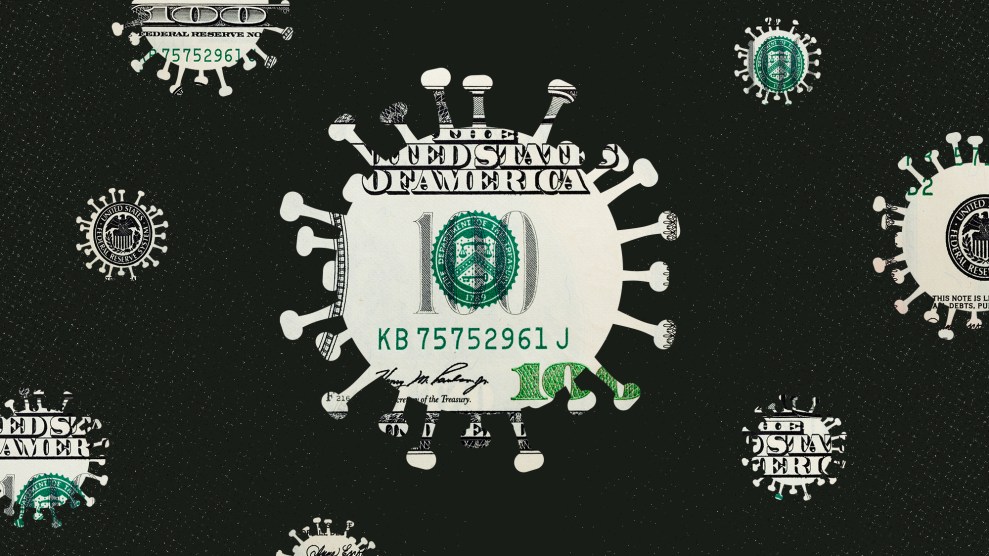
Comstock
With taxes due this week, it’s an apt time to consider some of the ways our federal tax code favors America’s wealthiest, and how a subset of those fortunate folks will use every trick in the book to game the system even further to their advantage.
Much of it revolves around the way the IRS taxes long-term investment profits—a.k.a. capital gains. President Joe Biden is asking people to pay a lot more on these profits. For decades, after all, the tax code has rewarded investors, particularly those at the very top of the nation’s wealth and income distributions, with very favorable rates. This policy is based on the long-debunked notion that the benefits of giving rich people even more money to invest will eventually trickle down and lift up the masses via job creation and so forth. (One report from the nonpartisan Congressional Research Service found no evidence that reducing tax rates for America’s upper crust increased the size of the nation’s economic pie, “but there may be a relationship to how the economic pie is sliced.”)
When you sell a long-term investment—one you’ve held for 12 months or more—in a stock, for example, or a work of art, or a private equity stake, you are taxed at a maximum of 15 or 20 percent on those profits, depending on your overall earnings. A family that brings in $500,000 in 2021 will pay a maximum 35 percent tax on work income but only 20 percent on capital gains. A household with $400,000 in income will pay up to 32 percent on wages, but only 15 percent on capital gains.
In other words, the tax code favors passive investment gains over actual work. This stands in opposition to the longstanding—perhaps mythical—American ideal that not only is hard work honorable, something to be encouraged and rewarded, but that all Americans should have equal opportunities. In fact, most Americans own little to no stock, while asset ownership soars as one moves up the wealth and income ladders. A proprietary analysis published by Goldman Sachs last year estimated that, as of late 2019, the wealthiest 1 percent of Americans owned a staggering 56 percent of all public and private equity held by US households. Since March 2020, meanwhile, America’s billionaires, despite the pandemic—and also because of it—have seen their collective wealth grow by more than $1.6 trillion.
The disparity in tax rates for work earnings versus investment earnings, which Biden hopes to eliminate, has been a major factor in the rapid growth of the wealth and income gap in recent decades. The disparity also drives financial behavior by wealthy individuals and corporations alike. It is why, for example, CEOs of large public corporations typically take home twice to three times their base salaries in preferred stock, stock options, and other nonwage compensation. Employees have to pay income and payroll taxes on the initial value of stock given in lieu of wages, but that stock may be undervalued, especially if granted prior to a public stock offering.
Tim O’Reilly, a prominent Silicon Valley publisher I met while researching my new book about the consequences of America’s wealth accumulation culture, told me about a conversation he had with a billionaire real-estate investor friend. “You have to understand, raising income taxes on the wealthy doesn’t really make much difference, because most of us avoid income,” O’Reilly recalls the friend saying. The guy had purchased his first building in Manhattan long ago for less than $10 million. Now it was worth hundreds of millions of dollars. Over the years, with the building as collateral, he had borrowed tens of millions to support his lavish lifestyle, which included a private jet. “I never got a penny of income,” he told O’Reilly. “I actually get a deduction for the money I live on.”
It also turns out that charging different rates on different types of income incentivizes all sorts of tax-avoidance strategies. Take carried interest, a lucrative loophole for fund managers that Biden may also try to eliminate. (Donald Trump promised to get rid of it, but never did.) Here’s how it works: Suppose you launch an investment fund—private equity, real estate, venture capital, a hedge fund—and recruit a bunch of rich investors and institutional pensions to bankroll it. The usual deal is that you charge your investors hefty annual fees for administering the fund. In exchange, assuming the fund is profitable, the investors are entitled to 100 percent of the gains up to a point—let’s say 8 percent. That’s called the “hurdle rate.” Any profits in excess of the hurdle rate are split 80/20 between the investors and the fund managers. This 20 percent is the “carried interest,” and though it really is little more than a performance bonus, it—and in some cases the administrative fees as well—can be reported to the IRS as long-term capital gains instead of wage compensation. This clever practice, deemed legal by the courts, has made many a fund manager ludicrously rich.
Wall Streeters are masters at coming up with tricks—legal or otherwise—to magically transform high-taxed income into low-taxed income. One notorious tactic was the “basket option.” For more than a decade starting in the late 1990s, Deutsche Bank and Barclay’s peddled this tax dodge to more than a dozen hedge funds, notably Renaissance Technologies (RenTech) and George Weiss Associates. That’s according to a Senate investigation and testimony from a 2014 Senate subcommittee hearing scrutinizing the practice.
The “basket” in question was merely a brokerage account containing a revolving collection of stocks. The trading was highly leveraged. The hedge funds put up 10 percent of the purchase price of the stocks and the banks fronted them the rest on credit. The fund managers picked the stocks and traded them at a very high frequency—more than 100,000 trades per day in RenTech’s case—to capitalize on small movements in the markets. The goal, according to then Sen. Carl Levin, a Michigan Democrat, was to pass off this “fictional option,” as he put it, as some kind of derivative product controlled by the banks (which collected more than $1 billion in fees), when in fact the hedge funds were always in charge.
Now, if you or I sell stock we’ve held for less than a year, the IRS considers that a “short-term” gain, taxed at the same rate as our wages. So these hedge funds would pile up mountains of short-term gains, then wait a year before cashing out the entire “basket”—at which point they would report the profits as long-term gains. The reason that long-term gains qualify for a lower rate, Levin emphasized during the hearing, is because, at least in theory, it encourages investment behavior that helps create jobs and grow the economy, as opposed to just using some sophisticated day trading algorithm. The basket option, in other words, was nothing but a parlor trick.
The banks stopped selling basket options by 2013, and the IRS issued guidelines two years later that retroactively held them and the fund managers to account. Senate investigators estimated that RenTech—founded by former math professor and NSA codebreaker Jim Simons (a top Democratic donor)—had used this tactic to shelter some $34 billion in profits and sidestep roughly $6.8 billion in taxes.
Weiss’ company, accused by the government of underreporting its income by $527 million in 2009 and 2010, took the IRS to court, hiring a pair of top-flight attorneys who also represented the Trump Organization on tax issues, according to Bloomberg; Renaissance told investors it was working with the IRS appeals office “to conclude this dispute.” Both cases remain active, but settling up would seem like a minor setback for Simons, who took home $1.8 billion in 2019. His $10 billion Medallion Fund, closed to outside investors, has been the best-performing hedge fund in the history of the planet.
Another ploy to convert short-term gains into long-term ones involves offshore reinsurance companies. In mid-2001, the trade magazine Institutional Investor reported that Max Re, a Bermuda-based reinsurer, had invested $342 million (about 40 percent of its portfolio), with a hedge fund company called Moore Holdings. Moore, in turn, held the single largest stake in Max Re. As it turned out, Max Re was operated by the brother of Wall Street hedge fund titan Louis Bacon, the founder of Moore Holdings. Other hedge funds were devising similar setups. What exactly was going on here?
Reinsurers make money by taking on some of the risk of retail insurance companies such as Allstate, State Farm, etc. They collect premiums from these firms and invest the money. Their business bet is that they will earn more money in returns from investing those premiums than they pay out in claims. But because reinsurers must be prepared to cover claims that arise, both insurers and reinsurers usually invest conservatively, in high-grade bonds and such.
Why hedge funds? As the CEO of a Caymans-based insurer put it to Institutional Investor, wealthy Americans weren’t doing it “for the insurance play…It’s always sold as a tax-efficient investment play.” Put simply, if I invest $5 million in a hedge fund, the IRS charges me 37 percent tax on any short-term gains the fund generates. But suppose instead I buy a $5 million stake in an offshore reinsurer, and that reinsurer then turns around and invests my money into the hedge fund in question. If the fund performs well, barring some insurance calamity, the value of my reinsurance company stake rises accordingly. And because the reinsurer is based in a tax haven, it pays little to no income tax on its investment profits, further boosting the value of my shares.
Thanks to special IRS rules for insurers, if I hold onto my reinsurance stake for 12 months, whatever profits I make when I sell them will be a long-term gain—taxable at 20 percent (assuming I’m a high-income individual) instead of the top income tax rate of 37 percent. That’s a fat discount, and this setup allows fund managers to solicit investments from public pension funds that are forbidden from buying into risky hedge fund bets—but are free to invest in insurance companies.
The IRS deemed the insurance scheme legal, unlike basket options, but the agency introduced a caveat that made it harder to pull off. To receive favorable tax treatment, hedge-fund reinsurers must now prove to the IRS that they are legitimate insurers, not just passive foreign tax shelters. That means they have to take on a fair amount of actual claims risk. If the hedge fund tanks or the reinsurer is crushed by unforeseen claims from a hurricane or whatever, the investors might lose their pants. But for American dynasties like the DeVoses, the Kochs, the Waltons—really any ludicrously rich family with an appetite for long-term risk and reward—such a play could still be pretty profitable.
If Biden can convince Congress to tax long-term gains at the same rate as wages and short-term gains—an uphill battle—a lot of these tricks would go away. But never underestimate the ability of the wealth industry to invent new ones. America’s billionaires have armies of lawyers working long hours on their behalf, scouring the tax codes for ambiguities that their clients might exploit. Tax reform is like a big game of Whac-a-Mole. And because the Republican Party has neutered the ability of the IRS to keep pace with the financial wizardry of the superwealthy, and to pursue high-income tax cheats, Congress would need to restore the agency’s funding to boot.
Rest assured that the superrich and their professional entourages, many of whom are quite keen on the status quo, will not go gentle into that good night.
This piece was updated to clarify that employees are taxed on the initial value of stock given in lieu of wages.
















